Today, electronic devices are getting more and more multi-functional, smarter, and smaller, and the circuit density is higher. To make an electronic device, various components are connected to a printed circuit board (PCB) or electronic mainboard to function properly. Circuit card assembly (CCA) is the process of mounting electronic components on a PCB.
Part 1: Circuit Card Assembly (CCA) vs. PCB

In short, a PCB is a blank circuit card, while a CCA is a PCB assembled with electronic components.
Circuit card assembly or CCA is another name for printed circuit board assembly or PCBA. It is an electronic module composed of a printed circuit board and various components.
A PCB or circuit card is laminated by alternating substrate, insulation, and conductive copper trace layers, and the copper traces in different layers are interconnected by copper-filled holes. The substrate material of a circuit card can be FR4, aluminum, copper, polyimide, polyester, PTFE, aluminum nitride, aluminum oxide, and glass. On the surface of the circuit card, a protective coating is silkscreen printed or sprayed on it. On the component-mounting side of the circuit card, the copper joints sprayed with a surface finish called PCB pads are used for connecting components.
Regarding electronic components, there are surface-mount devices (SMDs) and through-hole (THT) components. SMDs have very short pins or solder balls to connect the circuit card, while THT components have long pins to insert through PCB holes. SMDs are picked and placed by machines and then reflow soldered on PCB pads, and this CCA method is called surface-mount technology (SMT). SMT is automatic and suitable for the assembly of high-density circuit cards. THT components are inserted through PCB holes by hand or machine and then wave soldered. THT assembly is half-automatic.

A CCA is an assembly of a circuit card surface-mounted (SMT) and through-hole (THT) mounted with electronic components. It can be a semi-finished electronic product, which is later installed with an enclosure to be an end product. It can also be part of a system, which is later assembled with other CCA modules, components, and hardware to form a whole system.
CCA or PCBA manufacturing is an integral part of electronic manufacturing. When you finish the PCB design for an application, such as LED lights, routers, industrial controls, or so on, you will need to let a circuit card assembly manufacturer fabricate and assemble the circuit cards. And if possible, you can even let the CCA manufacturer assemble the circuit cards to be end products.
Part 2: Circuit Card Assembly Process
Below is the whole CCA manufacturing process from PCBONLINE's CCA manufacturing factory.
Because the CCA factory is dust-free, before entering it, we have to wear anti-static cloth, hat, and shoe covers, and take an air shower at the entrance.
- Step 1. Solder paste printing on circuit cards

The beginning of an SMT assembly line is a loader. It transfers the circuit cards one by one to the solder paste printing machine.

In a solder paste printing machine, the solder paste is pressed by a scraper to go through the openings of an SMT stencil to print on the PCB pads of the circuit card. Then the circuit card is sent to the next step.
- Step 2. Solder paste inspection (SPI)
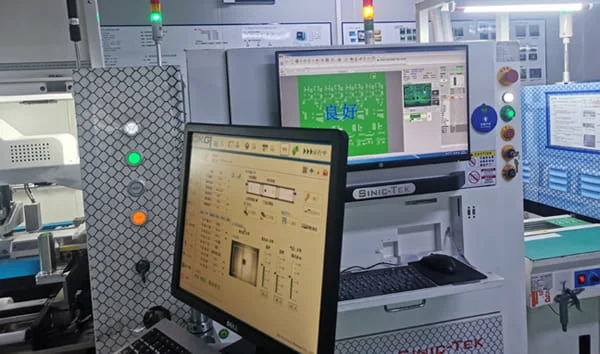
At this step, an SPI machine scans and compares the solder paste on the PCB pads with the pre-input specifications. This inspection makes sure the shape, size, thickness, and position of the solder paste are adequate for solderability.
- Step 3. Placing SMDs on circuit boards
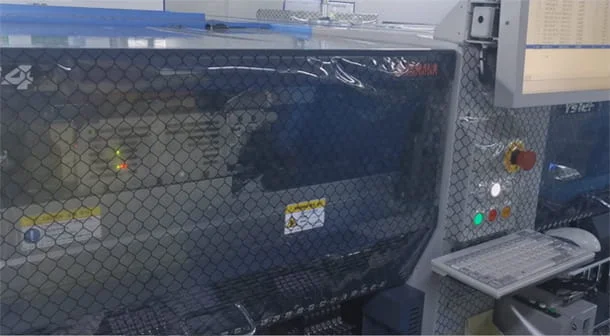
At this step, SMDs are picked and placed on the PCB pads of the circuit card. In a high-speed mounting machine, SMDs with smaller footprints are mounted on the circuit card, such as resistors, inductors, and capacitors.
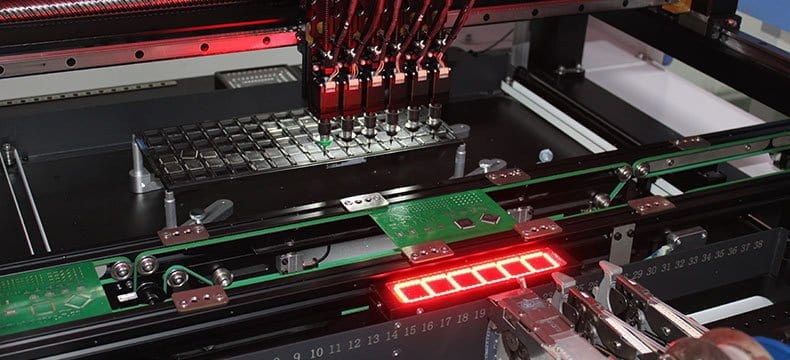
Later in a functional mounting machine, SMDs with larger footprints are placed on the circuit card, such as connectors and ICs.
- Step 4. Reflow soldering
If the SMDs include ball grid arrays (BGAs), the CCA should pass the X-ray inspection to ensure the solderability before reflow soldering.
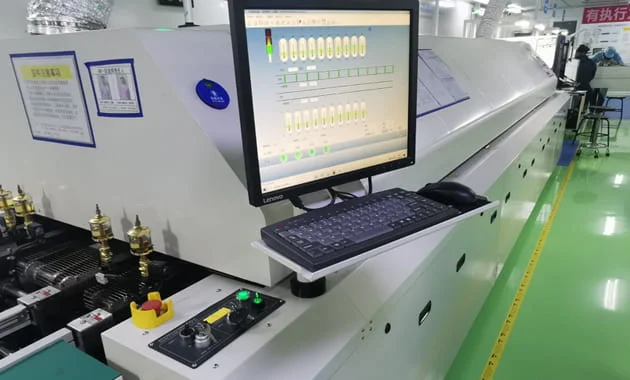
A reflow soldering oven has several temperature zones and can be programmed to adjust the temperatures and speed. In a reflow soldering oven, a CCA is preheated and baked. The solder paste melts, and the flux in the solder paste activates the solder and PCB pads for the phase change to form intermetallic compounds (IMC), which is a strong bond between the SMDs and the circuit card. For different CCAs, the reflow temperatures and periods are different, and the process follows the reflow temperature profile.
- Step 5. Automatic optical inspection (AOI)
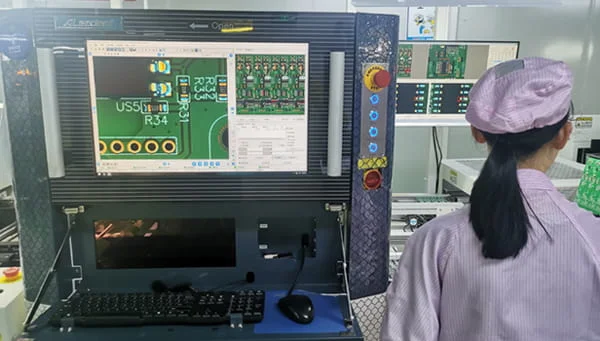
After reflow soldering, the CCA is scanned and compared with the pre-input specifications by an AOI machine. A quality control (QC) member stands in front of the screen to visually inspect the CCAs if they are inspected with any suspicions. Those CCAs with issues are later fixed and separated from the good ones since the AOI.
If the CCA has two component-mounting sides, it returns the start of the SMT line to mount the second side with components. After the SMT assembly, if the CCA has PCB holes that need mounting THT components, it goes to the THT assembly line.
- Step 6. Inserting the pins of THT components through PCB holes
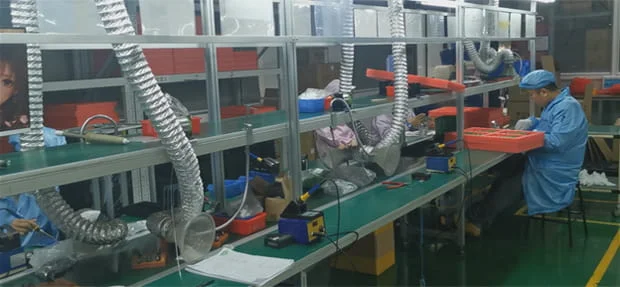
The pins of THT components such as fuses are inserted into the PCB through holes by hand or a machine.
- Step 7. Preheating and wave soldering
On a wave soldering line, the THT holes that need wave soldering are sprayed with flux and preheated first. Preheating activates the flux, removes moisture, and reduces thermal shock to the CCA when wave soldering.
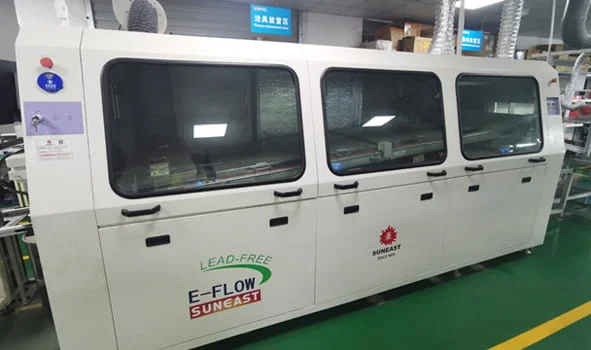
And then the PCB holes of the CCA that need a soldering soak in the liquid tin flows that keep a slope. Because the tin flows look like waves, it's called wave soldering. The wave soldering time and tin flow speed are programmed.
When the CCA leaves the wave soldering machine, a technician trims the THT component pins on the other side of the CCA to be 1mm to 2mm long. Another technician visually checks the CCA and fixes it anywhere if it is not soldered well.
At the end of the circuit card assembly process, we use the two probes of a multimeter to touch the testing pads of the CCA to see if the critical parts are okay.
Now, the CCA manufacturing process is complete. But it's not the end of the circuit card assembly. If you need conformal coating and other value-added services, you can enjoy value-added services in the CCA post-assembly stage. They include:
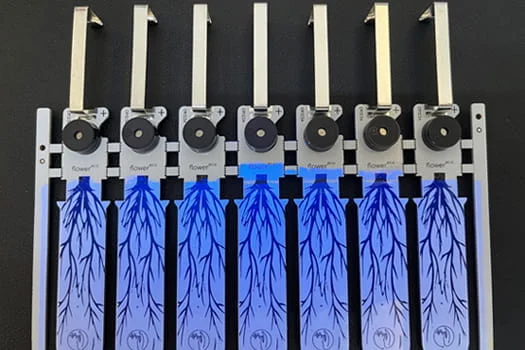
- Conformal coating - a urethane coating/polyurethane coating sprayed on the CCA to protect it against moisture, chemicals, dust, and vibration.
- Functional testing - placing a CCA on a jig/fixture and powering to test if the board works well. IC programming - transferring a program into the IC on the CCA.
- Further module assembly - by laminating or other ways to assemble the CCA with other hardware such as metal sheets, films, cables, or screws to be a more complex module. For example, cell contact system assembly for lithium-ion battery packs laminated from a flexible PCBA.
- Box build assembly - installing an enclosure onto the CCA or module to make it a system or an end product, including labeling and application simulation testing.
PCBONLINE provides all the above CCA manufacturing services without a minimum quantity limit. You can check the PCB assembly services to see more details such as assembly specifications from PCBONLINE.
Part 3: Circuit Card Assembly Manufacturer at One-Stop
If you are an original equipment manufacturer (OEM), research institute, or business maker, you can work with PCBONLINE for one-stop circuit card assembly. PCBONLINE is a CCA source factory manufacturer, and it has two large advanced PCB manufacturing bases and one EMS PCBA manufacturing factory.

By working with PCBONLINE, you can have CCAs manufactured from prototypes to massive production.
PCBONLINE provides free PCB design for manufacturing (DFM), CCA design for test (DFT) and assembly (DFA), and box build design for excellence (DFX)
One-stop CCA manufacturing services for your project, including PCB fabrication, circuit card assembly, CCA testing, and box-build assembly.
Strict quality control and complete testing for CCA, including SMT on-line tests and CCA tests in the post-assembly stage, such as functional testing, thermal aging, and application simulation tests.
Comprehensive value-added services for CCAs in the post-assembly stage, such as IC programming, conformal coating, and box-build assembly.
High-quality circuit card assembly following IPC-A-610 Class 2/3 standards and certified with ISO, IATF, RoHS, REACH, and UL.
One-on-one engineering support throughout your CCA project. Plus free samples and functional testing for massive manufacturing.
In the past 24 years, PCBONLINE has had rich CCA manufacturing experiences for automotive, industrial, communication, computing, medical, defense, biological, agricultural, and consumer electronics. If you want to get a quote from PCBONLINE, you can send your Gerber, BOM, and pick-and-place file to info@pcbonline.com.
Part 4: Advantages of CCA
Compared with hand soldering, circuit card assembly by a source factory is more precise and suitable for OEMs, business makers, and research institutes. The advantages of CCA include:
- High CCA quality and performance: SMT assembly has high reliability and is adequate for high-density circuits. With short SMD pins, the parasitic inductance and capacitance are small, and the high-frequency and high-speed performance of the circuit and the heat dissipation efficiency of the device are better. Even for THT assembly, its accuracy is much higher than that of manual welding.
- High efficiency: A CCA manufacturer such as PCBONLINE specializes in every aspect of circuit card assemblies, such as DFM, DFA, component sourcing, and CCA manufacturing, and it is quick to solve technical issues in your project. You can save a lot of time and energy in project optimization, testing, and electronics manufacturing.
- High cost-efficiency: relying on rich experiences, a CCA manufacturer can find issues in your Gerber and BOM before fabrication to avoid economic losses. And for massive CCA manufacturing, the unit price of automatic factory production is lower.
If you need PCBs and CCAs, by working with a source factory manufacturer, you can improve your design and ensure the quality of the product for an application.
Conclusion
This article introduces what a CCA is, the circuit card assembly process, and the advantages of CCA manufacturing. PCBONLINE is a CCA source factory manufacturer, which provides affordable and high-quality CCA manufacturing at one-stop. By working with PCBONLINE, besides PCB and CCA manufacturing, you can also get PCB optimization and one-on-one engineering support throughout your project.




